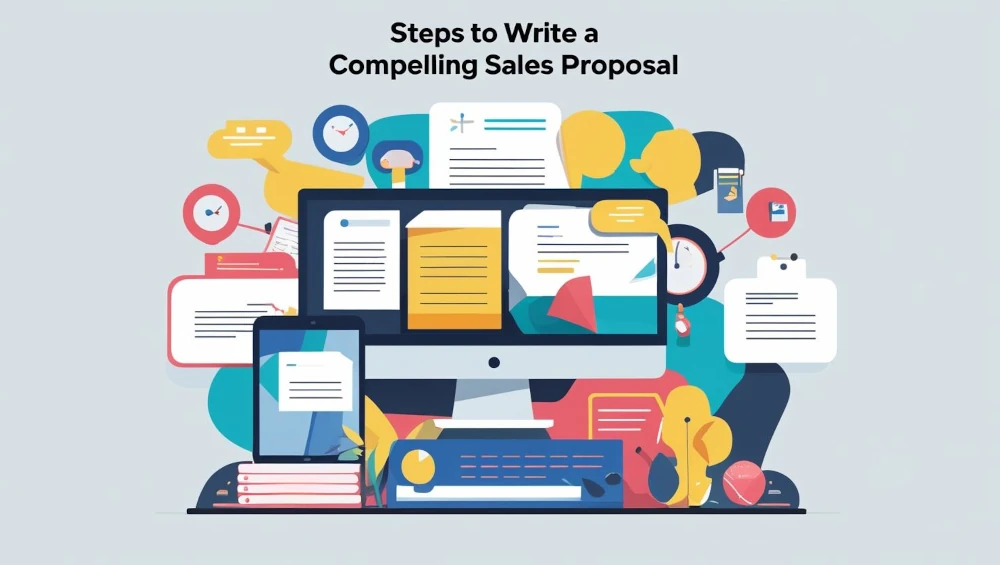Creating a sales proposal can be daunting, but it’s a crucial part of the sales process. It’s a document to persuade prospective clients to buy your product or service. It outlines what you’re offering and why it benefits the client. Crafting a compelling proposal requires a blend of technique, a deep understanding of client needs, and a well-presented approach. Below, we’ll explore the key components and steps to writing a sales proposal that captures attention and seals the deal. Keep reading to learn how to write a sales proposal that resonates with your clients and increases your chances of success.

Crafting a Compelling Executive Summary
The executive summary is where you capture your reader’s attention. This concise section outlines the most important aspects of your proposal, highlighting the solutions and benefits upfront. It should be impactful enough to persuade the client to continue reading, giving them a taste of how you intend to address their needs.
Despite its position at the beginning of the document, it’s often best to write the executive summary last. This way, you can distill the essence of your proposal, having already thought through all the details. The executive summary should encapsulate the client’s problem, your solution, the benefits, and the expected outcomes.
To write a truly effective executive summary, know what motivates your client. Is it cost reduction, increased efficiency, or market expansion? Use this understanding to highlight aspects of your solution that directly resonate with their priorities. Remember, this may be the only section top-level executives read, so make every word count.
While the executive summary should be succinct, it must also be complete. It must stand independently as a mini-proposal, emulating the larger document’s objectives and calls to action. Condensing complex solutions into a concise paragraph is an art, but doing so can significantly enhance the effectiveness of your sales proposal.
Outlining Solutions and Benefits in the Proposal

The core of your sales proposal lies in effectively communicating how your product or service can resolve the client’s issues or improve their situation. Start by clearly defining the problem or need, then describe your proposed solution in detail. The more tailored your solution to the client’s specific context, the more effective your proposal will be.
Benefits should be framed in a way that directly relates to your client’s objectives. What will they gain by implementing your solution? Think in terms of efficiency, profitability, or competitive advantage. If possible, the benefits should be tangible and quantifiable, as complex data often speaks louder than words when convincing a potential client.
In addition to outlining the practical benefits, it is also helpful to explore the strategic advantages of your solution. How does it position the client for future growth or adaptation to market changes? This forward-thinking approach can showcase your commitment to not just the immediate needs but also the long-term success of the client.
It’s also a pivotal moment to address potential objections. You thoroughly prepare by anticipating and strategically countering possible pushbacks within your proposal. This builds trust and shows you fully understand the domain and potential challenges the client may perceive in your solution.
Presenting a Clear Pricing Strategy and Timeframe
Transparency in pricing is a critical element in a sales proposal. Providing a clear and detailed breakdown of costs associated with your product or service can help prevent any misunderstandings and ensure transparency. Ensure that your pricing strategy is straightforward, justified, and in line with the value you’re offering.
Possessing a well-defined pricing strategy also expresses confidence in the value and effectiveness of your solution. It allows for realistic expectations and presents an opportunity to discuss any flexible pricing models or discounts that may be applicable. This openness can foster trust and further engage the client.
Alongside pricing, setting a clear timeframe for implementation and delivery is essential. This helps the client understand when they can expect to see the benefits of their investment. A realistic and well-articulated timeline also portrays you as a reliable and organized partner.
When discussing timeframes and pricing, always consider any variables that may affect these elements. Acknowledging these potential changes upfront displays professionalism and prepares the client for any eventual developments in the project lifecycle.
Overall, a well-crafted sales proposal is crucial for effectively communicating the value of your solution and establishing trust with prospective clients. By clearly outlining your approach, benefits, pricing, and timeline, you increase your chances of securing the deal and fostering long-term partnerships.


